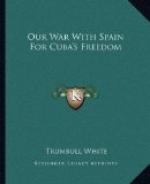Red-roofed buildings of stone and adobe entirely cover the hillside, with here and there a dome, a tower, a church steeple shooting upward, or a tell palm poking its head above a garden wall—the glittering green contrasting well with the ruddy tiles and the pink, gray, blue and yellow of the painted walls. In the golden light of a tropical morning it looks like an oriental town, between sapphire sea and turquoise mountains. Its low massive buildings, whose walls surround open courts, with pillared balconies and corridors, the great open windows protected by iron bars instead of glass, and roofs covered with earthen tiles—are a direct importation from Southern Spain, if not from further east. Tangiers, in Africa, is built upon a similar sloping hillside, and that capital of Morocco does not look a bit more Moorish than Santiago de Cuba. On the narrow strip of laud bordering the eastern edge of the harbor, the Moro at one end and the city at the other, are some villas, embowered in groves and gardens, which, we are told, belong mostly to Americans who are interested in the Cobre mines. The great iron piers on the right belong to the American mining companies, built for loading ore upon their ships.
Cardinas.
Fifty miles east of Matanzas is the city of Cardinas, the last port of any consequence on the north coast of the island. It has a population of 25,000, and is the capital of a fertile district. It is one of the main outlets of Cuba’s richest province, Matanzas, and is the great railroad center of the island, or, more properly speaking, it ought to be, as the railroads of the country form a junction fifteen miles inland, at an insignificant station called Jouvellenes.
In time of peace Cardinas enjoys a thriving business, particularly in sugar and molasses, its exports of the former sometimes amounting to 100,000 tons a year. To the west and south stretch the great sugar estates which have made this section of Spain’s domain a prize to be fought for. The water side of the town is faced with long wharves and lined with warehouses, and its extensive railway depot would do credit to any metropolis.
There are a few pretentious public buildings, including the customs house, hospital and college. Its cobble paved streets are considerably wider than those of Havana, and have two lines of horse cars. There is gas and electric light, and more two-story houses than one is accustomed to see on the island.
But, notwithstanding the broad, blue bay in front, and the Paseo, whose tall trees seem to be touching finger tips across the road, congratulating each other on the presence of eternal summer, Cardinas is not an attractive town. One misses the glamor of antiquity and historic interest which pervades Havana, Matanzas and Santiago, and feels somehow that the town is new without being modern, young but not youthful.
Other cities of importance.




